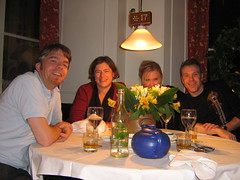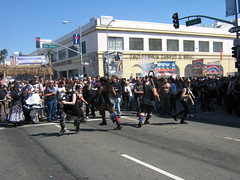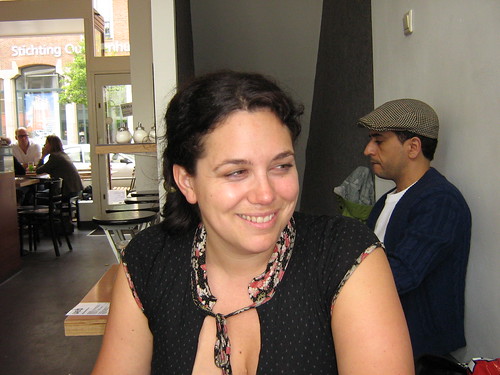I don't want to brag..well, actually I do. The panel went very well considering how many speakers we ended up with. Everyone kept to the time limit, no one had technical problems. And the talks themselves were all quite good; I think even exceptional in going beyond the anecdotal case studies we so often see when it comes to work on participation. Since we had so many speakers, there was really no time for discussion; that was the one downside, but I did have some short chats with people later on about our panel, so I guess they liked it.
Here is a link to my prior post which has links to all the full papers.
I also recorded audio for the whole panel and hope to eventually make podcasts for each speaker.
Big thanks to Elfi, Anders, Christian, and Mirko. You guys rock! :-)
Finally, I really have to thank Bernhard Rieder for his masterful work as respondent. He had quite a job having to read all five papers and find some way of summing them all up. I also recorded that, thankfully because Bernhard had good ideas that inspire further development of my ideas at least. --I heard the same from Elfi, in fact.
Tuesday, October 28, 2008
My Panel
Saturday, October 25, 2008
Marianne van den Boomen at IR 9.0
The next talk I saw was Marianne's; a much more developed version of the research she presented at New Network Theory in Summer '07. The title this time was "E-sociability metaphors:
From virtual community to social network and beyond," and looked at the evolution of metaphors used to describe social relationships on the Internet.
The most interesting point for me was the really concrete way she identified ways that Web 2.0 platforms in their technical workings actually might be described as undermining the previous kinds of online communities that were so much glorified.
As she puts it, Internet communities were once like this:
- localized social aggregation on the Internet
- based on shared practice, interest, or value
- gathering at a collective place
- having a core of recurrent active users
- engaged in on ongoing group communication
- and so developing a common frame
- of reference
- the page is dissolved as unit for collective gathering
- on the fly aggregation and reassemblage of user enriched data
- interacting data entities rather than interacting users
- no common collective place of gathering
- no ongoing debate between a recurrent group of users
While this is true, in fact, fora still exist, and people often interact through blog comments, wall-posts on Facebook, etc. But it's probably true that the focus is not any more on centralized "gathering places." Insteadit seems more like visiting neighbours, to me. Occassionally you all get together socially, but most interactions are one to one. But that is often what we do in person too, isn't it? Phone calls, meeting for coffee or lunch, sending email. Historically we might say that this is more typical, so I don't know that we can really blame web 2.0. On the other hand, I haven't researched the whole history of human intercation (yet!), so maybe this is so. SHould have asked about this at the talk, but I guess I can just send a message... ;-)
Thursday, October 23, 2008
IR 9.0 talk, Camille Paloque-Bergès: Internet as playful business : interactive hypertext in net.art
Ok, I went to this talk for two reasons, first because I am interested in the ways communities construct knowledge and in how we can observe that, and because Camille is a student of my friend Bernhard Rieder and I know how hard it can be as a grad student at a big conference, so I wanted to be supportive.
The talk itself was hampered by how little time was alotted to speakers in every panel--only 15 minutes instead of the usual 20. That missing 5 minutes equals 1-2 pages of text and it's quite a challenge to explain any but the most superficial ideas in only 15 minutes. Unfortunately Camille's talk was fairly complex, and I think it didn't all come across clearly. However, since she has posted her slides and paper, I was able to take a closer look and found that my initial impression was correct; she is onto something quite interesting.
I'll quote a short passage from her paper that sums up what she is studying right now:
From this quick contextualization, we can specify two major directions the net.artists have followed in Internet cyberculture: the economy of things (the growing population of hobbyists among the sub-cultures on the Web), embodied by informational objects (content and form) that are collected and shared in most of web communities, and the economy of people (triumphant in the Web 2.0’s fashion), embodied in the usage of applications, information processing and communication networks.In the talk she went on to discuss the example of nasty nets, a site that was active from 2006-2007 and at which a group of net.artists shared links and images of interest that they discovered while surfing, identifying an emerging vernacular that counters the serious or high culture (or hacker, which is an interesting connection) approaches to both the Internet and to net.art. Talking afterward, there was some thought that the 4chan "/b/" image board may be a good place (or even the best?) to spot the bleeding edge of memetic evolution online. --Not that we needed an excuse to visit it, but what the hell. ;-)
Wednesday, October 22, 2008
Talks at IR 9.0 -- Mimi Ito Keynote
Ok, I've had some more sleep and will start commenting on talks I saw. Honestly, I didn't see as many as I would have liked or register them as clearly as I should, because I was exhausted and sick for the whole trip, but I did at least see a few. I'll just mention the high points--otherwise know as the talks I can remember having attended!
In her keynote, Mimi Ito reported on a really large project being carried out at USC to look at youth culture and the internet, and she identified two kinds of participation, and focused on discussing the second. The first kind is not so different from kinds of socializing that have existed for a long time, but the latter is newer, or at least the extent to which it is available to teens is new and is allowed by the Internet.
1. Friendship-driven learning and participation
--hanging out
--overcoming limitations in local social network
--highly motivating to participants -- who are producers of knowledge and social reality
--social life becomes more public and persistently remembered.
--capacity building, jumping off point for...
2. Interest-driven learning and participation (Example, Naruto fans)
--expanding social networks beyond local groups
--unprecedented opportunity to connect with like-minded peers.
--learning new skills
--higher publicity potential
Naruto Fans who produce Anime Music Videos (AMVs) and who engage in Fan-subbing exhibit:
--high degree of collaboration and reciprocity
--mastering esoteric knowledge leads to status
--peer-based ecology of review and critique
--directed outward mainly to other subbers, but also to "leechers"
--become media creators--a moment of recognition and identity creation when they see something produced by another fan
--competing with industry
In general they found fans enjoyed:
- Diversity of genres of youth participation
- peer-based learning, participation, and reputation building
- small scale, local networks and communities
- accessing broader publics and audiences
- routing around traditional gatekeepers such as parents and teachers.
It was a nice talk with fun video examples, but I really wish she had done more than just describe the Naruto fan scene.
Monday, October 20, 2008
Mexican Restaurant in Denmark
Also, we came up with fun nicknames for certain people, and rules for others.
Cozy ambience
Part of a lovely dinner group
This is not a post
ok, of course it is, but not a real one.
By that I mean that I have a ton of things to post about the IR 9.0 conference and other things as well, but I'm exhausted and sick right now, so I can't muster the energy, will, brainpower, or anything else needed to compose something coherent.
Instead I will just say that I had a really good time seeing people I usually only see online. It was actually kind of strange at first because I noticed that I had gotten so accustomed to speaking with people individually through email, or FB messages, or Skype chats that being with them in a group where we all talked together felt very strange at first. But it was actually lovely, and sometimes a really amazing group chemistry would develop.
I also noticed that when most of your socializing is one on one, you can't develop much sense of what people are like in a general way, only of what they are like with you. So that's something to think about incorporating in my latest paper on Facebook.
So yes, all you people know who you are and I'll name you later when I talk in a more professional way. Now suffice to say that you all proved even nicer, smarter, and more fun in person than I had even expected. So thanks, people. :-)
--and yes, I just bet a few of you are almost feeling sick because I am writing in this so personal and gushy way on my, gasp, research blog. It's called leading the examined life, my dear ones. ;-)
Thursday, October 16, 2008
Tiny Update on IR 9.0
Good conference so far-- seen all interesting talks, but still so so jet-lagged. Really wish I could have come a day earlier to get more rest before it all started. Also, all European colleagues seem to have lighter workloads and more travel funding than I do...
I recorded the audio of our panel; will edit and post it next week and/or possibly coordinate it with slides for a podcast.
Friday, October 10, 2008
Papers for IR 9.0
Here is our panel, by the way:
Web 2.0 sites are praised for promoting sharing and collaboration; at the same time, they are criticized for violating user privacy and profiting from the free labor of users. This panel considers the complexity of relationships among users, and between users and system designers. In particular, each paper explores what motivates user behavior, whether website loyalty, desire for sociality, indoctrination in networked behavior, or the power relations among owners/designers, consumers, and prosumers.
Elfi Ettinger presents in-depth interview results from users of an e-recruiting platform and interviews with system designers of the same platform, conducted in order to determine which design would insure long-term participation of its users.
Anders Fagerjord relates a study of what Norwegian Facebook users publish about themselves in their profiles and the way they represent themselves through "prescripts" provided by popular applications and publishing tools.
Christian Ulrik Andersen analyzes the Facebook software interface, in particular the Vampires game, to explore its discursive and semantic properties and reveal the political aspects of the software.
Kim De Vries combines a rhetorical analysis with an auto-ethnographic study of academic and scholarly Facebook users to explore how we interpret the social connections made through social networking applications.
Mirko Tobias Schaefer explores user participation that in the last 10 years has developed on a global scale and now contributes to the development of software as well as changing, commenting, creating and distributing media content.
A collection of all the papers is posted on the IR 9.0 conference site, but only members can see it and some papers are slightly abridged, besides it being one giant file. You can see full, individual papers here:
Participation Inside? User activities between design and appropriation. by Mirko Tobias Schäfer
Networking Vampires -- Life in a social network seen through a game. by Christian Ulrik Andersen
Anders is missing ”is”: Posting and Prescripts on Facebook. by Anders Fagerjord
Sustainable e-Recruiting Portals: how can we motivate career-long applicant participation? by Elfi Ettinger
And I will add mine later today... Ok, I didn't, but it's finished and out for feedback, so probably by tomorrow night... damn, good feedback means revision...
Ok, here is mine though I am probably going to revise further; at least I feel this draft is not too embarrassing. Your Friend has just tackled you. Bite, lick, or tackle them back, or click here to theorize about what this all means.
Thursday, October 9, 2008
Some people are stupid...
Now, I am aware the Creative Commons Licenses are seen as problematic by some people in the FLOSS scene. Having said that, I think it is outrageous when someone uses a fairly generous flavor of the CC license, and still gets ripped off by someone else who refuses to listen when notified that they are violating even those minor requirements.
My friend Aaron posts about such an incident in his blog, and I refer you all to it here, in an effort to at least let people know what a JERK Jillian McDonald is being.
Tuesday, October 7, 2008
Goth Morris Dancers
More on the fair later...
And note that neither the other pictures on my Flickr set for the fair, nor the fair's site itself, are work safe. NOT SAFE AT ALL. Just so you know.
Update...
Ok, I still have two interviews left from summer-- Brenno de Winter and Florian Cramer. Florian's was 3 hours long, and was actually recorded! So that may take several entries at least...
But I'll put that on hold, for a bit. In a week I leave for IR 9.0, the Association for Internet Researchers 9th annual meeting, which is Copenhagen this year. I got two panels accepted but they got compressed into one because they were short on rooms and we lost a panelist, though that will be a pain, but on the other hand it should be a really fun panel. Also a good one; I know the work of all the participants from articles and other conferences and I am also happy to report that they already sent me full papers, which I'll link to soon. So none of those half-assed "done on the plane the night before" slide shows here. :-)
Also, on the last weekend of September, I went to San Francisco for Arse Elektronika where I got to meet Johannes Grenzfurthner and some others from Monochrom. I also met Aaron Muszalski, who was speaking at AE, and Richard Kadrey, author and photographer, who also spoke and did a reading. I managed a short interview with Johannes and talked to Richard at length on Friday before meeting him for an interview on Saturday. --They were all great! So reports on all of that are coming up.
Friday, October 3, 2008
Nancy Mauro-Flude Youthful Veteran of Dutch New Media
As mentioned earlier, I spoke with Nancy and Audrey together and this is Nancy's half of that conversation, plus info from a few, brief, subsequent chats.
I had been thinking of Nancy as part of the new generation in the Dutch new media art scene, but in fact she's been involved for 15 years though she only finished her MA at Piet Zwart in Spring 2007. Now on the one hand, maybe I am just ignorant, but also wonder why have I not heard of her before? I'm tempted to think this supports my contention that's women's participation is just not being documented. But in fact the scene is not very well documented overall. I will need to look at many examples before I can say for sure that one group of participants has been differently reported than another.
Anyway, Nancy has been on the scene for quite some time but in this conversation we mostly talked about the Genderchangers and differences between that environment and her experiences learning about tech in other venues. Nancy didn't seem to feel she had encountered as much impatience over her lack of tech experience in academic programs, but she took it for granted that she'd had to prove herself to "the boys" in other tech groups, or just generally techie guys.
I find very surprising how little attention she seems to have garnered, because she has been doing interesting, technically ambitious work for quite some time, yet doesn't seem to get what I would consider the attention she deserves. Particularly interesting to me are the projects that combine a performance, which is ephemeral, with creation of an artistic tool which may have many future uses. For example, one of her most recent projects is Bag Lady. Follow this link to a description/review by Mirko Schaefer.
I need to talk more with Nancy, and get the story of those 15 years.






